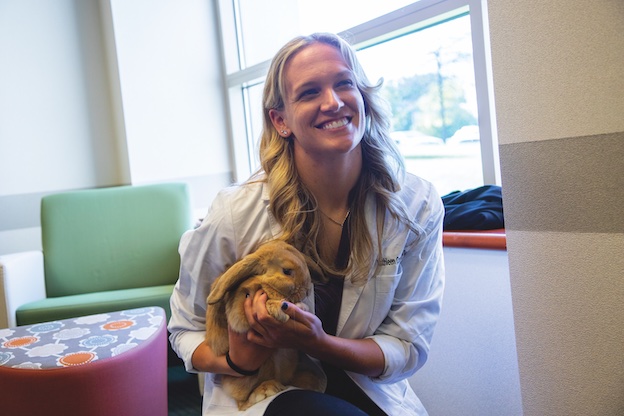“You never know what’s going to walk in through the doors,” says Kate Crossman ’14, emergency clinician at Metropolitan Veterinary Associates. “I’m really intrigued by the challenge of that.”
At this 24-hour veterinary hospital, Crossman sees a variety of cases. A new pet owner is nervous when her dog vomited and wants reassurance that it isn’t anything serious. Another owner is crying and yelling as he brings in his cat who has been hit by a car. A couple brings in their elderly dog with cancer to be euthanized.
Crossman acknowledges that seeing pets in pain can be difficult. “But after some interventions and treatments, a surprising number of them really seem to bounce back,” she says. “They are incredibly resilient.”
Being a veterinarian is challenging, and so is becoming one. North America has only a handful of veterinary schools. Crossman, who majored in biology and chemistry, felt pressure to be the perfect applicant. But Jean Shingle, Ph.D., her biology professor and advisor, told her, “We’re going to figure out how to get you there.”
Shingle and her late colleague Carl Pratt, Ph.D. (“In Remembrance of Our Beloved Faculty”), expanded a vertebrate zoology class from one semester to two so that Crossman could fulfill her prerequisites. Immaculata now offers a pre-veterinary minor for the increasing number of students interested in the field.
Crossman remembers attending one of the biology department’s colloquiums when the head of microbiology at the University of Pennsylvania’s veterinary school spoke about her work and her career path. “I kind of hovered back after the talk was done,” Crossman recalls. Then she turned to see James K. Murray, Ph.D., her chemistry professor, who knew she wanted to become a vet, and he urged her to connect with the speaker. The woman invited Crossman to tour her lab, and Crossman completed a summer internship there—“an excellent opportunity,” she said.
Crossman’s professors also provided feedback on her veterinary school application materials. They spotted a minor criticism in one of her letters of recommendation, allowing her to replace it with a better one. She appreciated how attentive they were. “They extended their help and support every step of the way,” she adds.
Crossman obtained her Doctor of Veterinary Medicine at the University of Prince Edward Island Atlantic Veterinary College in 2018. She finds it rewarding to work with owners as a team to care for their pets.
“Everybody is different as far as how they treat and work with their pets,” she says. Some people prefer to treat their pets’ symptoms rather than incurring the cost of diagnostic tests. Other owners want to do lots of interventions. Crossman says, “I will never become desensitized to having to perform humane euthanasia.” But, she adds, “For me, it’s all a matter of perspective.” For older animals with poor quality of life, or for pets who have been in a life-threatening accident, Crossman says, “euthanasia is not unkind.”
Crossman mentions compassion fatigue as a common problem in her field. Because pet adoptions surged during the pandemic, she notes, many veterinary clinics are booked out for months, and some vets have burned out and left the industry.
Still, Crossman finds joy in her work. She mentions caring for a 14-year-old diabetic cat who spent multiple days in the hospital in critical condition. Crossman called the owner and encouraged him to consider euthanasia to end his cat’s suffering. He wanted to use a veterinary hospice service to have her put to sleep at home with him. But his cat suffered a stroke, and Crossman called him again, warning that the cat might not survive the trip home. But when the owner came to the hospital, his cat suddenly lifted her head, looked at him and started purring.
“That cat was remarkable!” Crossman says. “Sometimes they show some spirit there that always takes me by surprise.” The owner later thanked her—his cat had been able to undergo humane euthanasia in the comfort of her own home.
Crossman recalls another pet in critical condition, a dog with internal perforations from swallowing a container of thumb tacks. Crossman and her colleagues performed surgery to remove the tacks but felt concerned about the dog’s outcome. “He was running around the exam room the next day. Amazing!” she said. As she talked with the owner, they looked down to see the dog diving into the trash can. Crossman laughs and says the owner asked his dog, “Don’t you remember why you came here in the first place?”
“The greatest joy is genuinely helping animals in their time of need. I think that animals do a lot for us on a daily basis—they’re our support team,” Crossman reflects. “It surprises me sometimes what they can get through with the proper support and the proper care.”
8 Tips for Pet Owners
- Consider purchasing pet insurance, which an be helpful financially. Some emergency procedures can cost several thousand dollars, and it is always better to be prepared.
- Microchip your pets. If they run away, and are taken to a facility, their owners can be found sooner rather than later.
- To alleviate vet-related anxiety, introduce your pets when they’re young to different people and environments. And help them get used to being handled—hold them, touch their legs and nails, rub their ears and pull back their lips and feel their gums and teeth. Then it won’t be so abnormal when their veterinarian examines them.
- Pet obesity increases the risk of heart disease, diabetes, joint problems and more. So make sure your pet gets enough physical activity and eats an appropriate diet. Exercise dogs appropriately, and enrich a cat’s environment with scratching posts and climbing towers.
- Keep in mind that pets have different metabolisms than humans. Human food is often too high in sodium and fat for dogs, which can lead to gastrointestinal upset and more severe conditions such as pancreatitis. Chocolate, raisins, grapes, macadamia nuts, almonds, onions and garlic are all dangerous for dogs. Also, many processed foods contain xylitol, an artificial sweetener that may lead to acute liver injury.
- The ingredients in pet food are not always regulated. Look for over-the-counter pet food brands made by veterinarians and veterinary nutritionists to ensure adequate nutrients.
- Pets can be sensitive to extreme temperatures, especially heat. Panting is a dog’s way to diffuse excess heat, but in the small space of a car, the heat can’t escape. Think again before leaving your dog in a running, air-conditioned car. What if you get delayed and the car runs out of gas, or the AC malfunctions? On hot days a pet can experience heatstroke in just a few minutes. Before you walk your dog, see if the pavement feels too hot on your skin, and walk in the grass or at a cooler time of day.
- In the winter ice and salt products can be tough on a dog’s paw pads and skin, so gently wipe your dog’s paws after coming inside, and avoid strenuous exercise on tough terrain.






